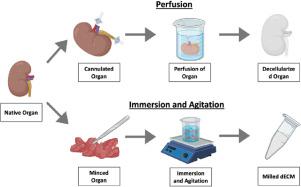Acta Biomaterialia ( IF 9.4 ) Pub Date : 2020-08-07 , DOI: 10.1016/j.actbio.2020.07.060 Deepak Choudhury 1 , Marcus Yee 2 , Zach Lee Jia Sheng 1 , Ahmad Amirul 1 , May Win Naing 1

|
Extracellular matrix (ECM) is a natural biomaterial scaffold that provides biochemical and structural support to its surrounding cells, forming tissue and respective organs. These ECM proteins can be extracted from organs and tissues through decellularization, which is the process of removing cellular content and nuclear material from the organs to obtain decellularized ECM (dECM). dECM is a versatile and functional biomaterial that can be used as the base component of bioinks for rebuilding tissue and organs. Intact dECM of whole organs can be used as a scaffold for recellularization with human stem cells to produce a functioning organ. As decellularization is a relatively new lab process, the associated technologies and devices are largely non-standardized and only available in small, lab-specific scales. Additionally, there is a lack of standardized protocols to analyze the quality and consistency of harvested dECM for medical applications. This review discusses the relevant decellularization systems and devices currently available to facilitate further development of this process for larger scales with the intention to commercialize dECM materials.
Statement of Significance
Extracellular matrix (ECM) is a natural cocktail of biomaterials that provides biochemical and structural support to its surrounding cells. ECM proteins are extracted from organs and tissues through decellularization. Being a versatile and functional biomaterial, decellularized extracellular matrix (dECM) is being used as base component of bioinks/hydrogels for rebuilding of tissue and organ constructs. Decellularization is a relatively new lab process with associated technologies/devices being largely non-standardized and only available in lab-specific scales. We discuss categories of decellularization systems and devices for the first time being used in academic and commercial settings. We highlight inherent challenges with the current systems and suggest possible solutions. We comment on further development of these processes for large-scale and commercial applications of dECM.
中文翻译:

脱细胞系统和设备:最先进的。
细胞外基质(ECM)是一种天然生物材料支架,可为其周围的细胞提供生化和结构支持,形成组织和各个器官。这些ECM蛋白可以通过脱细胞从器官和组织中提取,脱细胞是从器官中去除细胞成分和核物质以获得脱细胞ECM(dECM)的过程。dECM是一种多功能且功能强大的生物材料,可以用作重建组织和器官的生物墨水的基本成分。完整器官的完整dECM可用作与人干细胞进行细胞再生以产生功能性器官的支架。由于脱细胞是相对较新的实验室过程,因此相关的技术和设备在很大程度上尚未标准化,只能在特定于实验室的小规模范围内使用。另外,缺乏标准化协议来分析用于医疗应用的dECM的质量和一致性。这篇综述讨论了目前可用的相关脱细胞系统和设备,以促进该方法的大规模开发,以期将dECM材料商业化。
重要声明
细胞外基质(ECM)是生物材料的天然混合物,可为其周围的细胞提供生化和结构支持。ECM蛋白通过脱细胞从器官和组织中提取。作为一种多功能的功能性生物材料,脱细胞的细胞外基质(dECM)被用作生物墨水/水凝胶的基本成分,用于重建组织和器官构造。脱细胞化是一个相对较新的实验室过程,相关技术/设备在很大程度上尚未标准化,只能在特定于实验室的规模下使用。我们将首次在学术和商业环境中讨论脱细胞系统和设备的类别。我们重点介绍了当前系统所固有的挑战,并提出了可能的解决方案。











































 京公网安备 11010802027423号
京公网安备 11010802027423号